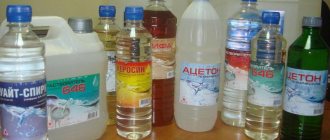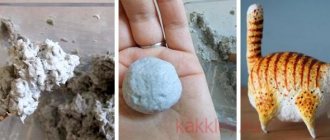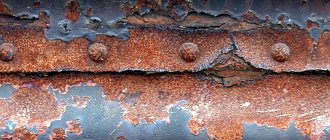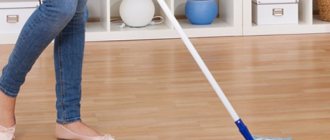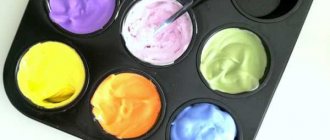How to paint tires on a car?
To paint a car tire, you need to do the following:
- Inflate the tire to the specified pressure.
- Sand the rubber with sandpaper.
- Degrease the surface to be painted with white spirit or another solvent.
- Warm and mix the paint.
- Apply 2 coats of paint with a brush at intervals of 24 hours.
Interesting materials:
Why do children need a TIN? Why is User Account Control needed? What is the corridor for? What is cross fit for? What is leucine needed for? Why do you need a layout in a presentation? Why do you need a washing vacuum cleaner? What is Monopotassium Phosphate used for? What is Opti Men used for? Why do you need steam in an iron?
Tools and materials
To paint tires you will need:
- dye;
- brush or spray gun;
- mounting tape;
- degreasing liquid;
- emery;
- napkin.
Having collected the necessary materials, it is worth deciding on the coloring technology. The most popular paint scheme today is White Wall: the dye is applied in an even layer to the side surface of the tires. This technology is economical, since less paint is consumed. The working surface of the wheel remains black. The result is a retro style, a combination of black and white, although in general you can choose any color you want. Some are simply limited to painting over the name of the model and brand.
When applying permanent inscriptions, individual letters or patterns on rubber, use the Edding 8050 marker with a solid aluminum body and a hard tip.
This ink is applied in short strokes, as it dries instantly without leaving any odor. These inscriptions last quite a long time.
DIY tire painting
Painted wheel at home
When starting the painting process, carry out the preparatory work:
- inflate tires to operating pressure;
- Wash the surface of the tire from dirt; for this purpose, you can use soda diluted with water to a mushy state;
- degrease the surface of the tire using alcohol or solvent;
- Allow the tire to dry completely.
Required tools and materials:
- paint for rubber;
- a special brush or spray gun, you can use a marker with paint;
- masking tape;
- means for degreasing rubber surfaces;
- a napkin or sponge for wiping away stains.
When starting painting, heat the sealant a little so it adheres better to the rubber surface. If you plan to make an inscription or design on the tire, then use masking tape to get a clear line. You can paint a tire well by applying several layers of paint, about 2-3 layers. Painted rubber can be used 24 hours after applying the final coat of paint.
When applying certain lines or symbols to rubber, consider:
- You should not make a thick line in the middle of the tire; it will visually divide the tire into two parts.
- Drawing a thin line down the middle of the tire will make the wheel appear smaller.
- You can visually blur the outline of the wheel and make it unclear by applying a contrasting line along the outer edge of the tire.
- The line along the inner contour of the tire visually makes the tire profile smaller and increases the size of the rims.
Of the presented options for applying a line, the most advantageous are stripes along the inner kennel of the product. It should be taken into account that such tuning of low-profile tires will make the tire bead too thin: the tire will look ridiculous.
You should also avoid incorrect combinations of several colors. For example, it is not recommended to tune green wheels with red tires if the car body is gray. The best option is when the inscription matches the color of the body or serves as its contrast.
Scope of use
First of all, this type of paint was chosen by car enthusiasts, those who strive in any way to distinguish their car from surrounding vehicles. Moreover, auto tuning is gaining popularity every year, and painted tires can really turn your car into an exclusive one, filling it with individuality. And here it is very important to choose the most suitable paint correctly.
The circumstance of high mechanical loads and the negative impact of external factors on the wheels of a moving car will become completely natural. The more obvious the fact becomes - ordinary acrylic or enamel paint compositions are not able to withstand the pressure exerted. They will simply peel off, falling off in pieces.
Products based on rubber or polyurethane will allow you to achieve the highest quality and lasting coloring. With their help, it becomes much easier to form an elastic layer of sufficient strength that is not afraid of stress in the form of tension and compression.
Methods for restoring the color of tires without using paint
Blackening of tires
The process of blackening tires involves coating the tire with a special liquid - ink. You can buy such a product at the car market or in special stores. The range of factory inks is represented by two types of blackening mixtures:
- "Brilliant." These substances are usually made on the basis of a lubricant with a silicone composition. When applied to a tire, the surface of the rubber becomes glossy. At the same time, “shiny” products wash well and do not wash off after several washes. The disadvantage of these inks is that they heavily stain the surface. If the stain gets on the surface of the car, the body will have to be washed for a very long time. Therefore, when applying these products to rubber, you must observe safety precautions (use rubber gloves, avoid contact of substances with the skin).
- "Matte." These products do not provide a mirror-like surface to the tires after applying the substance to the tire, but they do add brightness to the color of the tire. The appearance of tires after using these blackening agents becomes bright, better than that of new tires. Disadvantages include:
- shorter lifespan than “shiny” substances: “matte” ones are easier to wash off with water;
- absorb quickly.
In addition to improving the appearance of tires, inks protect rubber from the external negative effects of sunlight, water, chemicals, and so on. The protective function of these substances is possible due to the creation of a thin film on the surface of the tire.
We recommend watching a video about blackening tires at home:
Why do tire blackening?
Vehicle safety is ensured by regular maintenance. But if the body, components and parts can be repaired, then the damaged tires will have to be replaced. It loses its elasticity from acid precipitation and winter chemical mixtures. When exposed to sunlight, tires fade, harden and crack. The cracks become clogged with dirt and small stones. As a result, the service life of the wheels is reduced .
Blackening your tires will extend their life and restore their performance.
Why ink is needed:
- they return rich color to the wheels;
- create a water-repellent film on the surface;
- soften rubber;
- mask microcracks and minor defects;
- protect tires from further cracking.
The blackener is used for more than just tires. It is used to treat bumpers and moldings (if they are black), rubber seals on car doors to prevent freezing in cold weather.
It is not necessary to blacken the tires at a service station. Car cosmetics manufacturers offer a wide selection of conditioners, polishes, restorers and other protective coatings. All that remains is to choose the appropriate composition and brand and carry out the processing yourself.
Related material: 14 best car polishes for 2022 (rating)
What is important to know
The tire painting technology consists of partial painting; this is caused by an uneven arrangement (that is, one part of the tire is hidden, and its main surface is constantly in “contact” with the road). When driving for a long time, the tire is subject to rapid wear of the tint coating. This is why it is wrong to compare painting the body and painting the tires of a vehicle.
In most cases, white paint is used for rubber items, which highlights all the features of the wheels. However, tuning companies have a wide variety of shades, both neutral and bright colors. Black paint and well-pigmented colors are used to decorate collectible cars due to their high cost and certain difficulties in application. On the contrary, the white color of the composition is relatively inexpensive and does not require special skills in painting work.
Difficulties may arise in painting narrow tires made of low-profile rubber; in such cases, partial tinting of individual areas or surface highlighting of some inscription or image is used.
When choosing continuous painting, the painted surface of the tires should be left to dry for a while so that the paint applies more evenly and subsequently there are no abrasions, bald spots or chips. For partial painting, it is recommended to use special paint markers; now they can be found in almost any automotive store.
Recommendations
Considering the cost of glycerin, as well as the relatively low consumption and excellent effect, this method is one of the best in terms of quality and price. For this reason, it is recommended to treat rubber with glycerin regularly.
We also recommend reading the article on how to choose the right car tires based on their markings. From this article you will learn what tire markings mean, as well as what features you should pay special attention to when selecting tires for your car.
It is also advisable to periodically treat tires with silicone to preserve the appearance and protect the surface of the tires from exposure to ultraviolet radiation and “drying out.”
Combined with proper rubber storage conditions, the overall service life of car tires can be significantly increased with this approach.
Rezel+
Universal waterproofing paint Rezel+.
The main components of the dye are acrylic resin and latex. Thanks to the water base, toxicity and odor are completely absent during the painting process and the use of the painted surface.
The dried film is a complete waterproofing coating, and is extremely wear-resistant: the manufacturer recommends using Rezel+ for painting floors in garages, tennis courts and garden paths.
- The appearance of the paint after drying is a white matte film. It looks great on the ceiling and walls; in particular, the author of the article used this type of dye when decorating the bathroom. However, the colors of rubber paint are not limited to white: it can be tinted with any water-soluble pigments.
Attention: the entire volume of paint is tinted at once. A slight change in the amount of pigment in different portions will cause the painted surfaces to differ in shade.
Pigments for tinting water-based dyes.
- Despite being water-based, the dye (like all acrylate paints) can withstand up to five freezing cycles.
- The film obtained by painting does not burn and is resistant to alkali solutions, acids, gasoline and oil.
- Consumption for single-layer painting is approximately 200 grams per square meter.
- The mass fraction of non-volatile substances is 47 percent.
- Drying time for one layer “touch-free” at room temperature is about an hour. Final polymerization with full strength gains occurs within 24 hours.
- The price of a kilogram of paint is a rather modest 130-150 rubles per kilogram.
How to prepare the surface and apply dye with your own hands? What surfaces can be painted?
Rezel+ can be used on any surface without any restrictions; It is recommended to prime ceramics, metal and plastic before painting. The paint was tested by the author on concrete, plywood, steel, plasterboard and OSB (including over alkyd enamel); The strength of the coating and its waterproofing properties did not cause the slightest criticism.
The balcony is waterproofed with rubber paint.
How is painting with rubber done?
- Rust, dust and other contaminants are carefully removed from the base. The previously painted surface is washed with soda or washing powder. Surfaces stained with oil or solarium are degreased with paint solvent.
- The paint is thoroughly mixed and applied to the surface using a brush or roller in two or three layers with intermediate drying. Airless spraying is acceptable. The temperature of the air and the base should not be lower than +5 C (water base, remember?).
- Loads and moisture are permissible after complete polymerization of the last layer - one day after painting.
An airless spray gun is used for painting.
We analyzed the consumer properties of just two dyes from a huge group of paints made from rubber and for rubber. More information about other members of these families can be found in the video in this article. Good luck!
Nuances when choosing
And yet, how to paint rubber, what paint is suitable for the wheel tires of a vehicle? This is a rather complex issue, so before buying paint it is better to consult with a specialist (depending on the purpose, the seller will select the appropriate modification of the coloring composition for you).
To paint tires, you cannot use standard acrylic or enamel paints, since car wheels constantly experience increased mechanical stress (such paint mixtures are not able to withstand prolonged mechanical stress).
Let us highlight the main criteria that paints must meet:
- high degree of adhesion to rubber;
- good elasticity after drying on the surface;
- strength and wear resistance.
KCH-136
Properties
Rubber paint KCh-136 is produced according to technical specifications TU 301-10-1172-74. The composition includes natural rubber, pigment (carbon black or titanium white) and a polymer binder. Thinner – white spirit.
It is curious that water-dispersed dyes are also produced on the basis of rubber.
The coating obtained by painting is resistant to atmospheric influences (which, in fact, is indicated by the first number of the marking, indicating the possibility of external use of the dye). In addition, it can tolerate prolonged contact with fresh and salt water and limited contact with fuels and lubricants.
What other information can be found on the websites of manufacturers and sellers?
- To protect the rubber, it is recommended to paint at least two layers. To mark rubber products, it is enough to apply one layer through a stencil.
- Black KCh-136 absorbs almost all the light falling on it: no more than one and a half percent is reflected in the visible part of the spectrum.
- Enamel is thixotropic, that is, it liquefies under mechanical stress and becomes viscous at rest. From a practical point of view, this means that the coating applied to the surface will level out on its own: marks from a brush or paint roller will quickly disappear, leaving no streaks.
- The mass fraction of non-volatile substances is 20-30% for black enamel and 35-40 for white.
- Working viscosity – 50-130 seconds.
Let us remind you: viscosity is measured by a capillary viscometer with a nozzle with a diameter of 4 millimeters at a temperature of +20 C. Significant temperature deviations will affect the accuracy of measurements.
The photo shows the simplest tool for measuring paint viscosity.
- Painting is possible at temperatures from -20 to +30C.
- Consumption when painting with a roller or brush will be 110-120 g/m2; when using a pneumatic sprayer it will increase to 150-170 g/m2.
- Drying time for one layer “touch-free” is no more than 4 hours at room temperature.
- The approximate service life of the coating is 4 years.
- Paint viscosity in din: table
Application
We found out how to paint rubber. How to paint rubber to achieve the maximum possible service life of the applied coating?
The instructions will not amaze the reader with complexity.
- The surface to be painted is cleaned of dust, dirt and remnants of old coatings.
- Rubber is degreased with white spirit, alcohol or another solvent.
- The coating is applied in one or two layers with a brush, roller, spray gun or by dipping the part.
